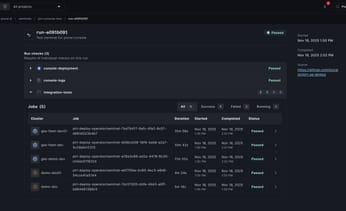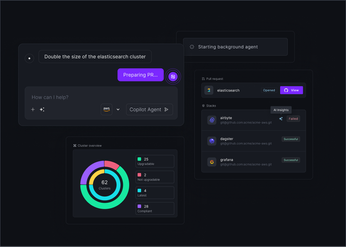
Kubernetes CNI: The Ultimate Guide
Understand CNI Kubernetes essentials with this comprehensive guide, covering plugins, network policies, and best practices for optimal cluster performance.
Selecting the networking layer for your Kubernetes cluster is a foundational decision—one that impacts performance, security, observability, and day-to-day operations. The Kubernetes Container Network Interface (CNI) standard enables a wide range of powerful networking plugins, but this flexibility often leads to decision fatigue.
Do you prioritize robust network policy enforcement with Calico? Do you want cutting-edge eBPF performance and observability with Cilium? Or do you prefer the simplicity and low operational overhead of Flannel? Each option presents a different set of trade-offs in terms of scalability, complexity, security features, and cloud-native integration.
This guide breaks down the most popular CNI plugins used in production Kubernetes environments. We'll compare them across key criteria, such as performance, security capabilities, and ease of management, so you can choose the best-fit solution for your infrastructure and business goals.
Unified Cloud Orchestration for Kubernetes
Manage Kubernetes at scale through a single, enterprise-ready platform.
Key takeaways:
- CNI provides essential flexibility: Kubernetes intentionally delegates networking to CNI plugins, allowing you to select a solution tailored to your specific needs—whether it's Calico for robust security policies, Cilium for high performance with eBPF, or Flannel for simplicity.
- Choosing a CNI is a strategic trade-off: The right plugin depends on your priorities. Evaluate the trade-offs between performance (direct routing vs. overlay networks), security capabilities (like
NetworkPolicyenforcement), and operational complexity to find the best fit for your architecture. - Automate CNI management for fleet-wide consistency: Manually managing CNI configurations across clusters leads to drift and errors. Use a GitOps-driven approach, like Plural’s Global Services, to automate the deployment, configuration, and upgrades of your CNI, ensuring your network layer is consistent and secure at scale.
What Is CNI and Why Does Kubernetes Need It?
Kubernetes is exceptional at orchestrating containers—but it deliberately avoids handling networking directly. While that might seem like a limitation, it's actually a thoughtful design choice. Instead of enforcing a single networking model, Kubernetes delegates this responsibility to specialized plugins through a well-defined specification: the Container Network Interface (CNI).
CNI is a Cloud Native Computing Foundation (CNCF) project and the de facto standard for connecting containers in Kubernetes. By remaining unopinionated about the implementation, Kubernetes gives platform teams the freedom to choose a networking solution that aligns with their infrastructure, performance needs, and security requirements.
This modular approach is powerful. It enables flexibility across different use cases:
- Want to enforce fine-grained security policies between microservices? Choose Calico.
- Need simple overlay networking for a dev environment? Use Flannel.
- Running latency-sensitive workloads at scale? Leverage Cilium with eBPF support.
This pluggable architecture makes it possible to build Kubernetes clusters that are secure, scalable, and tuned for your workloads. But to make the right choice, you need to understand how CNI works under the hood.
Understanding CNI
At its core, CNI is a specification that defines how network plugins should interact with container runtimes like containerd or CRI-O. It provides a plugin-based interface for configuring network interfaces when containers are created or destroyed.
Written in Go, CNI consists of:
- A set of libraries and standards
- Executable plugins that handle real networking tasks
- An interface used by the container runtime to trigger networking setup
When a pod is launched, the container runtime calls the CNI plugin configured on that node. This plugin:
- Creates a network interface in the pod’s network namespace
- Assigns a unique IP address via IP Address Management (IPAM)
- Sets up routing so the pod can communicate with other pods and external endpoints
This abstraction allows Kubernetes to support a diverse ecosystem of CNI plugins, from basic connectivity providers to feature-rich platforms with encryption, observability, and advanced policy control.
The Role of CNI in Pod Communication
The main job of CNI in Kubernetes is to ensure reliable pod-to-pod communication—both within a node and across nodes in the cluster.
Here’s how it works:
- When a pod is scheduled, the kubelet invokes the CNI plugin on that node.
- The plugin creates a virtual network interface in the pod's namespace.
- A unique IP address is assigned to the pod from a configured pool.
- Routing is configured so the pod can reach:
- Other pods in the cluster (usually without NAT)
- External services (based on network policy)
- If supported, network policies and encryption are applied.
This seamless, automated process is what enables the Kubernetes networking model, where “every pod can communicate with every other pod, without NAT.”
CNI plugins are the tools that make this possible. They ensure your services can scale, communicate, and remain secure across environments—whether you're running a single-node dev cluster or a multi-cloud production deployment.
How CNI Works with Kubernetes
The Container Network Interface (CNI) provides a standardized, pluggable mechanism for container networking in Kubernetes. When a pod is scheduled, the kubelet on that node delegates network configuration to the selected CNI plugin. This interaction is what allows Kubernetes to support a wide variety of networking solutions, from simple overlays to complex BGP-based fabrics. The CNI specification defines a simple contract: the kubelet executes a CNI plugin binary to perform network operations like adding or removing a pod from the network. This clear separation of concerns is fundamental to Kubernetes' flexibility. Before diving into specific CNI plugin options like Calico, Flannel, or Cilium, it's essential to grasp the fundamentals of this interaction.
The lifecycle of a CNI plugin
When a pod is created and assigned to a node, the kubelet initiates a precise sequence of events to establish its network connectivity. First, the kubelet invokes the configured CNI plugin, passing metadata about the pod, such as its network namespace. The plugin then executes the ADD command, creating and configuring the network interface inside the pod's namespace. This typically involves creating a virtual Ethernet (veth) pair, placing one end inside the pod's namespace and the other in the host's root namespace. After assigning an IP address and setting up necessary routes, the plugin reports the configuration back to the kubelet, which completes the pod's initialization. This interaction between pods, services, kube-proxy, and CNI forms the networking foundation within a Kubernetes cluster.
How CNI handles IP allocation and routing
A core responsibility of any CNI plugin is IP Address Management (IPAM). Each plugin is responsible for assigning a unique IP address to every pod from a pre-configured CIDR block associated with the node. This process ensures that no two pods have the same IP, preventing conflicts within the cluster. However, managing these IP ranges can become a significant operational challenge. To avoid issues with misconfigured or overlapping CIDR IP ranges, it’s critical to configure the Kubernetes control plane carefully from the start. This problem often stems from the default Kubernetes behavior where each node might use the same pod IP range if not explicitly defined. Using an Infrastructure as Code approach, as managed by Plural, helps enforce consistent and non-overlapping network configurations across your entire fleet, mitigating these risks at scale.
A Comparison of Popular CNI Plugins
The CNI landscape offers a range of plugins, each with different strengths. There's no single "best" choice; the right plugin depends entirely on your specific requirements for network policy, performance, scalability, and operational simplicity. Are you building a highly secure, multi-tenant platform, or do you need a straightforward solution for a small cluster? Answering this question is the first step. Below, we compare four popular CNI plugins to help you evaluate your options. Once you decide, Plural can help you standardize the deployment and configuration of your chosen CNI across your entire fleet using our Global Services feature, ensuring consistency and reducing management overhead.
Calico: For robust network policy
Calico is a top choice for teams that prioritize granular network security. It provides powerful network policy enforcement by creating a flat layer-3 network that can use BGP to route packets directly without an overlay. This approach not only delivers high performance but also makes network policies more straightforward to implement and debug. Calico's IPAM and CNI plugins work together to connect pods and manage IP addresses efficiently. If your architecture requires strict traffic control between services, multi-tenancy, or integration with on-premises data centers that already speak BGP, Calico offers the flexibility and robust feature set you need to build a secure and scalable network foundation for your clusters.
Flannel: For simple overlay networking
If you need a simple, reliable networking layer without a steep learning curve, Flannel is an excellent starting point. It’s designed to be a minimal and easy-to-configure CNI that provides a basic overlay network, typically using VXLAN to encapsulate traffic between hosts. This design allows containers on different hosts to communicate as if they were on the same network, abstracting away the complexity of the underlying infrastructure. While it doesn't have the extensive policy features of Calico, Flannel is a lightweight and stable option for clusters where advanced network segmentation isn't a primary concern. Its focus on simplicity makes it one of the most popular CNI providers for getting a Kubernetes network up and running quickly.
Cilium: For eBPF-powered performance
Cilium leverages a powerful Linux kernel technology called eBPF to provide networking, observability, and security. By operating directly within the kernel, Cilium can enforce network policies and route traffic with significantly lower overhead than traditional iptables-based solutions. This results in high-performance networking and provides deep visibility into traffic flows, including application-layer (L7) policies for protocols like HTTP and gRPC. Cilium uses VXLAN by default but can also run in a direct routing mode for even better performance. It's an ideal choice for modern, high-traffic microservices architectures, though it requires a relatively recent Linux kernel (5.2+), which is an important operational consideration.
Weave Net: For resilient mesh networking
Weave Net creates a full mesh network among all nodes in your cluster, which simplifies networking and enhances resilience. A key feature is its ability to automatically re-route traffic around network failures without manual intervention. Weave Net provides out-of-the-box encryption for all traffic between hosts, making it a strong choice for security-conscious teams that need to protect data in transit. It's designed to "just work" with minimal configuration, creating an encrypted overlay network that allows for easy communication between containers across different hosts. If your priorities are operational simplicity, resilience, and built-in security, Weave Net offers a compelling and battle-tested solution for your Kubernetes clusters.
How to Choose the Right CNI Plugin
Selecting a CNI plugin is a foundational decision for any Kubernetes cluster. It's not just a technical detail—it directly shapes how your applications communicate, how you enforce network policies, and how your team manages the network layer. The right choice depends on your specific requirements for performance, security, scalability, and operational complexity. A well-informed decision upfront will prevent significant operational challenges later.
Key Decision Factors
Start by ensuring that any plugin you consider is compliant with the Container Network Interface (CNI) specification, ideally version 1.0.0 or newer.
Beyond compliance, your decision should reflect your workload and operational needs:
- Network policies: Do you need basic ingress/egress controls, or are you aiming for zero-trust segmentation between services?
- Infrastructure environment: Are you running on-prem with BGP-based networking, or in a public cloud with tightly integrated VPCs?
- Advanced features: Some CNIs offer built-in traffic encryption, eBPF observability, or Layer 7 policy enforcement—features that may be essential for your use case.
Performance and Scalability Trade-Offs
Each CNI plugin makes deliberate trade-offs:
- Overlay-based CNIs like Flannel use VXLAN to encapsulate traffic between nodes. This simplifies networking but can introduce additional latency and overhead.
- Routing-based CNIs like Calico bypass overlays using BGP, offering better performance and lower latency at the cost of more complex configuration.
- eBPF-powered CNIs like Cilium operate within the Linux kernel, enabling high-throughput, low-latency networking and deep observability—but they require modern kernel support (5.2+).
If you're managing a large-scale microservices architecture or latency-sensitive workloads, these architectural differences matter.
Cloud Provider Compatibility
Your cloud platform plays a crucial role in CNI selection:
- Managed Kubernetes services such as Amazon EKS, Google GKE, and Azure AKS typically come with default CNIs optimized for their networking stacks.
- Installing third-party CNIs on managed clusters is possible but may come with limitations or integration challenges.
- For hybrid or multi-cloud environments, cloud-agnostic options like Calico or Cilium offer consistent policy enforcement and networking across clusters.
This is where a platform like Plural becomes invaluable. Instead of configuring CNIs individually for each cluster, you can define a single Global Service resource to standardize the deployment and management of your preferred CNI across all environments—ensuring consistency and reducing operational overhead.
Implementing CNI: Common Challenges and Best Practices
While CNI plugins are essential for Kubernetes networking, their implementation introduces operational complexities that teams must manage. From initial deployment to ongoing maintenance, making the right choices is critical for building a stable, performant, and secure cluster. Addressing these challenges proactively prevents cascading failures and ensures your networking layer can scale with your applications.
Common Deployment Challenges
One of the most frequent deployment issues involves IP address management. Misconfiguring the pod CIDR block during cluster initialization—often when using kubeadm—can lead to IP address exhaustion or conflicts with other networks in your environment. It’s a foundational error that can be difficult to correct later without significant disruption.
Another challenge is simply selecting the right plugin. The ideal choice depends heavily on your specific environment—a simple overlay network might suffice for a development cluster, but a high-performance, on-premises deployment may require a plugin with BGP support for optimal routing. These Kubernetes networking challenges require careful planning to avoid rework.
Strategies for Optimizing Performance
A poorly configured CNI can quickly become a network bottleneck, introducing latency and limiting throughput between services. The encapsulation method used by overlay networks (like VXLAN) adds overhead to each packet, which can impact performance for latency-sensitive applications.
To optimize performance:
- Consider CNI plugins that leverage eBPF, like Cilium, to bypass parts of the kernel’s networking stack for more efficient packet processing.
- For on-premise clusters, plugins like Calico that support BGP integration can eliminate encapsulation overhead entirely.
Regularly monitor network latency and bandwidth using observability tools like Prometheus and Grafana to identify and address bottlenecks before they impact users.
Security Best Practices
By default, Kubernetes allows all pods to communicate with each other, creating a flat network where a single compromised container could access any other service. Implementing a zero-trust security model is a crucial best practice.
This starts with choosing a CNI plugin that robustly enforces Kubernetes NetworkPolicies. Plugins like Calico and Cilium excel at this, allowing you to define granular traffic rules between pods and namespaces.
For organizations managing multiple clusters, maintaining a consistent security posture is key. Platforms like Plural simplify this with their Global Services feature, enabling you to define a single set of network policies and apply them uniformly across your entire fleet—ensuring consistent enforcement everywhere.
Using CNI for Kubernetes Network Policies
While CNI plugins handle the fundamental tasks of IP address management and routing, their role extends into a critical domain: network security. Kubernetes provides a native resource called NetworkPolicy to define rules for traffic flow between pods. However, Kubernetes itself does not enforce these rules. The enforcement is the responsibility of the CNI plugin. This is a crucial distinction—if your chosen CNI plugin does not support NetworkPolicy, any policies you create will have no effect.
Plugins like Calico, Cilium, and Weave Net are designed with policy enforcement as a core feature. When you apply a NetworkPolicy manifest to a cluster, the CNI plugin translates those declarative rules into concrete actions on the node's networking stack, using technologies like iptables, IPVS, or eBPF. This allows you to create sophisticated, application-aware security boundaries directly within your cluster, isolating workloads and minimizing the attack surface without needing external firewalls. This capability is fundamental for building secure, multi-tenant environments or implementing a zero-trust security model within a microservices architecture. By offloading enforcement to the CNI, Kubernetes remains a declarative control plane, while the CNI plugin handles the low-level implementation details specific to the node's operating system.
How to implement network segmentation
Network segmentation is the practice of dividing a network into smaller, isolated subnets to control traffic flow and contain security breaches. CNI plugins enable you to implement network segmentation effectively by defining how pods communicate with each other and with external services. For example, you can create a policy that allows pods with the label app: backend to receive traffic from pods labeled app: frontend on a specific port, while denying all other ingress traffic. This segmentation is crucial for isolating workloads and managing traffic flow within a multi-tenant or microservices-based Kubernetes cluster, ensuring that a compromise in one service does not immediately grant access to others.
Enhancing security with network policies
Network policies in Kubernetes provide a powerful mechanism to control the communication between pods. By leveraging a CNI that supports them, you can enforce rules that dictate which pods can communicate, thereby enhancing the security posture of your applications. A common best practice is to implement a default-deny policy, which blocks all pod-to-pod traffic unless explicitly allowed by another policy. This zero-trust approach is essential for protecting sensitive data. However, managing these policies consistently across a large fleet of clusters can introduce significant operational overhead. Plural’s Global Services feature simplifies this by allowing you to define a single baseline security policy and replicate it across your entire fleet, ensuring a consistent and secure configuration everywhere.
Monitoring and Troubleshooting CNI
CNI plugins are critical to Kubernetes networking—but they can also become a source of elusive, high-impact failures. Since the interaction between pods, services, and the CNI layer forms the backbone of cluster communication, even small misconfigurations can snowball into application outages or degraded performance. Network policy misfires, overlay breakdowns, and IP exhaustion often manifest as vague service errors, forcing platform teams to play detective without clear clues.
Establishing strong observability and a systematic debugging workflow isn't just good practice—it's a prerequisite for operating production-grade Kubernetes environments. Let’s explore how to monitor CNI health and quickly troubleshoot issues when things go wrong.
Tools for Monitoring CNI Health
Observability for your CNI should start with plugin-native diagnostics and extend to centralized, multi-cluster platforms.
- Native Tools: Most CNIs come with built-in tools. Use
calicoctlfor Calico orcilium monitorfor Cilium to inspect network flows, policy enforcement, and IP allocation at a low level. - Prometheus & Grafana: Expose CNI-specific metrics like IPAM stats, policy hits/misses, and encapsulation overhead by configuring Prometheus to scrape your plugin’s DaemonSet metrics endpoints.
- Plural’s Unified Dashboard: Plural simplifies fleet-wide visibility by aggregating CNI health metrics—like policy violations or IP pool usage—into a single pane of glass across all your clusters.
This layered approach gives you the real-time data needed to catch issues early and track the long-term health of your networking layer.
How to Debug Common Networking Issues
Many CNI issues boil down to a few familiar culprits:
- IP Exhaustion: Misconfigured pod CIDR ranges (especially during
kubeadmsetup) can result in too few assignable IPs. Check IP pool availability and overlapping ranges with plugin tools or Kubernetes API queries. - Broken Pod-to-Pod Connectivity: Look for conflicting or overly restrictive NetworkPolicy rules. If you're using an overlay network like VXLAN, inspect encapsulation or MTU mismatches.
- DNS Failures: CNI doesn’t handle DNS directly, but network misconfigurations can break CoreDNS. Use
kubectl execanddigto verify resolution inside pods.
A Step-by-Step Debugging Process:
- Start with
kubectl describe podto catch obvious pod-level networking errors. - Inspect CNI DaemonSet logs (e.g.,
calico-node,cilium-agent) on the affected nodes. - Use plugin-specific CLI tools to inspect flows, policies, or BPF maps.
- Trace packets, if necessary, using tools like
tcpdumpinside the pod namespace.
Pro Tip: In large environments, correlating logs, metrics, and events manually is inefficient and error-prone. Plural’s AI Insight Engine automates this process by scanning across telemetry sources to perform root cause analysis and suggest actionable fixes.
By combining proactive observability with smart debugging practices, you can prevent minor CNI missteps from becoming major incidents—and keep your Kubernetes cluster stable, performant, and secure.
How Plural Simplifies CNI Management
While CNI plugins are foundational to Kubernetes networking, managing their lifecycle—deployment, configuration, upgrades, and troubleshooting—across multiple clusters can become operationally burdensome. Each cluster requires a correctly configured CNI to function reliably, but maintaining consistency manually doesn’t scale and increases the risk of misconfigurations, network partitions, downtime, or security gaps.
Plural streamlines this entire process by managing CNI like any other component—through a unified, GitOps-based workflow. Instead of relying on custom scripts or manual steps per cluster, Plural uses its Continuous Deployment Engine to abstract away complexity. Platform teams can define, deploy, and maintain their CNI plugins across any number of clusters from a single control plane. This GitOps-native approach drastically reduces operational overhead and shifts engineering focus back to delivering value, not wrangling networking infrastructure.
Automate CNI Deployment and Configuration
Plural lets you automate CNI plugin deployment and configuration across your fleet. Using Global Services, you can define CNI configurations once in a Git repository and automatically propagate them to targeted clusters. This declarative model eliminates configuration drift, minimizes human error, and ensures reliable, consistent networking. Whether you're deploying Calico for network policy enforcement or Cilium for eBPF-powered performance, Plural turns complex setups into repeatable workflows managed as code.
Use Integrated Monitoring and Troubleshooting
Plural offers built-in observability tools for inspecting CNI health and performance. Its integrated Kubernetes dashboard gives you a single pane of glass to monitor CNI pods, logs, events, and resources—no need to manage kubeconfigs or jump between clusters. When issues occur, Plural’s AI Insight Engine performs automated root cause analysis, correlating CNI logs, metrics, and configurations with cluster activity to quickly identify and resolve networking problems.
Streamline CNI Upgrades and Maintenance
CNI plugin upgrades are often high-risk, but Plural reduces this friction through its GitOps-driven upgrade pipeline. Simply update your CNI version or configuration in Git, and Plural’s deployment engine safely rolls out the changes across your fleet. You can also integrate approval gates and staging environments into your workflow to validate changes before pushing to production. This allows your networking stack to stay current and secure—without manual overhead or downtime.
Related Articles
- Kubernetes CNI: Kubernetes Networking Explained (2025)
- Kubernetes CNI: The Ultimate Guide (2025)
- Master Kubernetes Networking: A Deep Dive Guide
Unified Cloud Orchestration for Kubernetes
Manage Kubernetes at scale through a single, enterprise-ready platform.
Frequently Asked Questions
Can I change my CNI plugin on a live Kubernetes cluster? While it is technically possible, changing the CNI plugin on a running cluster is a complex and high-risk operation. It often requires careful planning, potential application downtime, and a multi-step migration process to avoid network partitioning. Because the CNI is fundamental to all pod networking, a failed migration can leave your cluster in a broken state. It's far better to invest time in selecting the right CNI for your needs during the initial cluster design phase.
What's the main difference between an overlay network and direct routing? An overlay network, commonly using VXLAN, creates a virtual network on top of your existing physical network. It encapsulates pod traffic in new packets, which makes it simple to set up as it abstracts away the underlying network topology. In contrast, direct routing, often using BGP, configures the physical network to route traffic directly to pods. This approach avoids encapsulation overhead, resulting in higher performance, but it requires more complex network configuration and integration with your network hardware.
Why is eBPF mentioned so much with CNI plugins like Cilium? eBPF is a technology that allows programs to run safely inside the Linux kernel without changing the kernel's source code. For networking, this is a significant advancement. CNI plugins like Cilium use eBPF to process network packets far more efficiently than traditional methods like iptables. This results in lower latency, higher throughput, and provides deeper visibility into network traffic, which is why it's become a key feature for high-performance and security-focused use cases.
If Kubernetes has a NetworkPolicy resource, why do I need a specific CNI plugin to enforce it? Kubernetes itself does not enforce network policies. The NetworkPolicy resource is simply a declarative API object that defines traffic rules. It is the responsibility of the CNI plugin to read these policy objects and translate them into actual firewall rules on each node. If you use a CNI plugin that doesn't support network policies, any NetworkPolicy resources you create will be ignored, and your pods will be able to communicate freely.
How does Plural's Global Services feature help with managing CNI across many clusters? Managing CNI configurations and network policies consistently across a large fleet of clusters is a significant operational challenge. Plural's Global Services feature solves this by allowing you to define your CNI configuration and associated network policies once in a central Git repository. Plural then automates the deployment of this configuration to all designated clusters, ensuring uniformity and eliminating configuration drift. This turns a complex, manual task into a reliable, GitOps-driven workflow.
Newsletter
Join the newsletter to receive the latest updates in your inbox.









